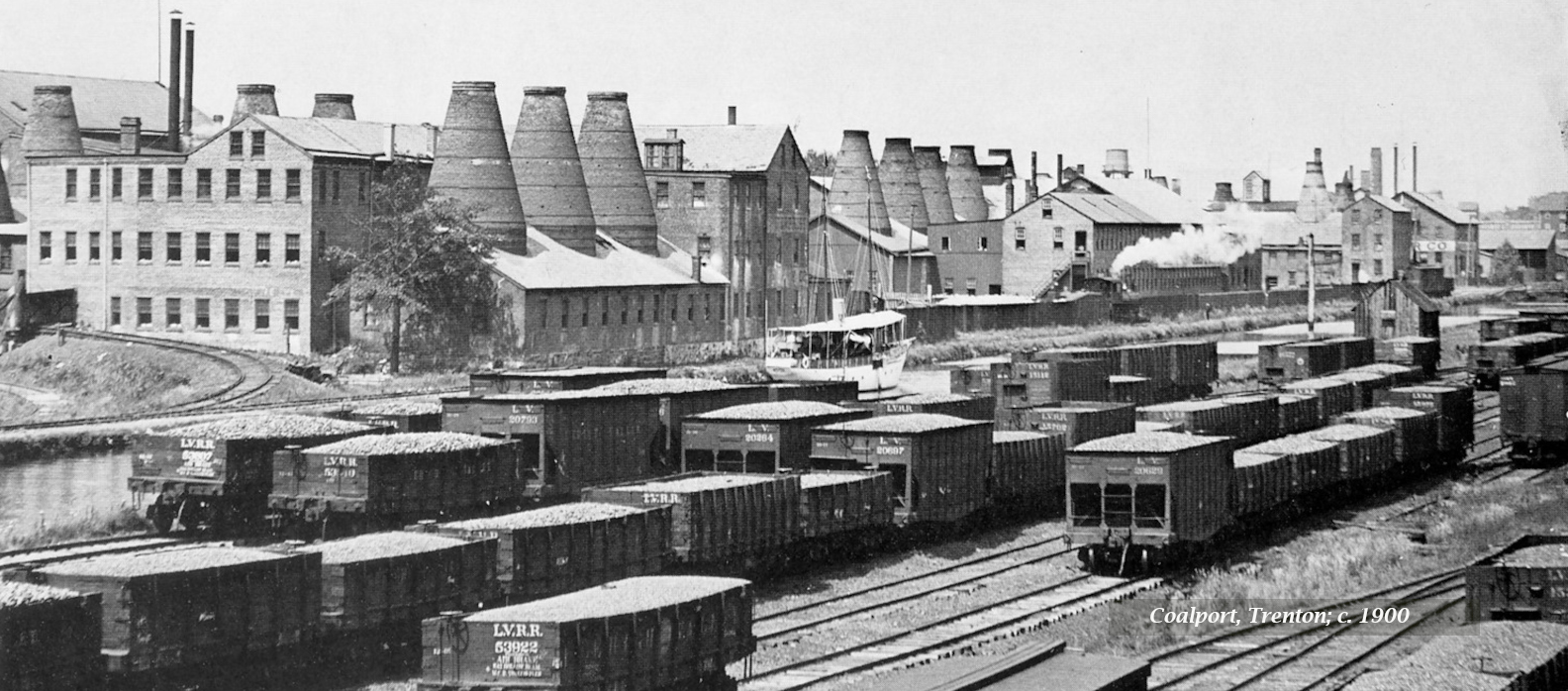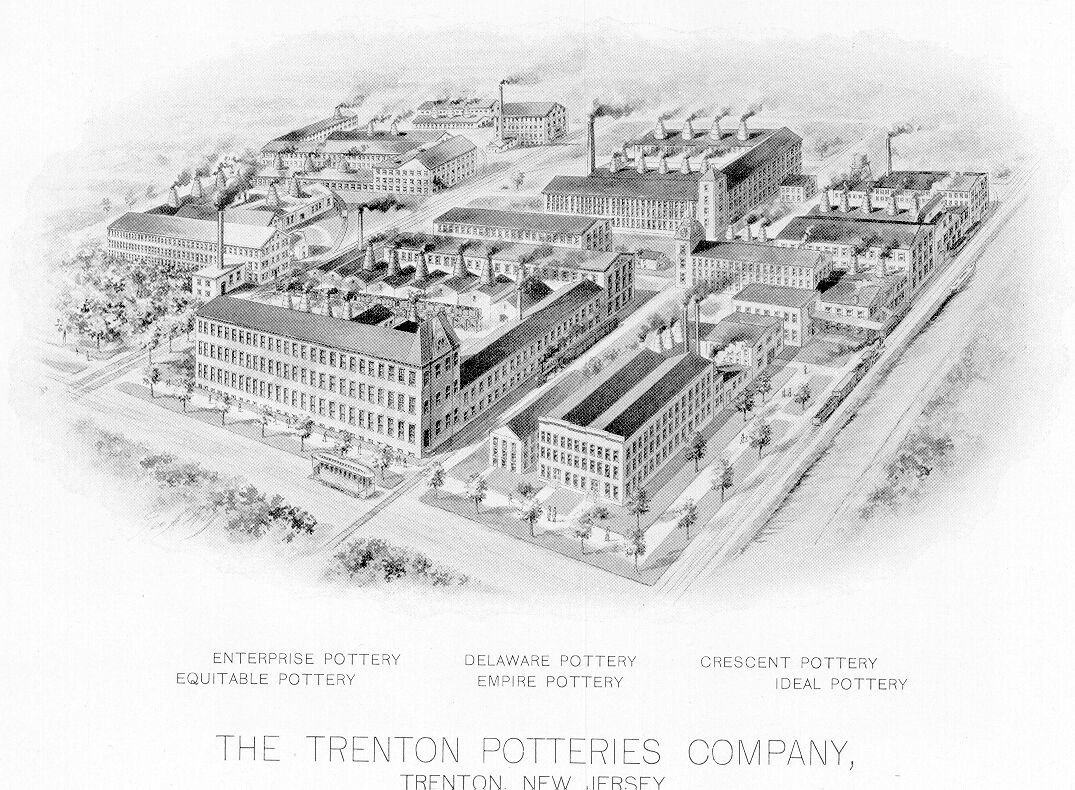TRENTON'S INDUSTRIAL POTTERIES
Trenton was once home to a thriving pottery industry, with beehive kilns dotting the city’s landscape and smoke from burning coal filling the air. Trenton’s potteries produced all sorts of ceramic goods: kitchenware such as bowls, plates, cups and food molds; decorative art like vases, figurines and statues; sanitary wares such as toilets, bathtubs, sinks and urinals; and many specialty items including electric insulators, crucibles, and glove molds (for the rubber industry). At the peak of the industry, between roughly 1870 and 1920, only one other industrial center in the United States (East Liverpool, Ohio) came close to challenging Trenton as the nation’s leader in pottery manufacture.

The Delaware and Raritan Canal played a key role in the growth of the Trenton potteries during the second half of the 19th century. The city’s central location in relation to raw materials and markets, and its easy access to canals and railroads, were critical to the development and survival of its ceramic industry. The Delaware and Raritan Feeder Canal, together with the Delaware Canal and the Belvidere-Delaware Railroad, brought coal from Pennsylvania to power equipment and to fuel the kilns. The main stem of the Delaware and Raritan Canal, along with the Camden & Amboy Railroad and the Delaware & Bound Brook Railroad, hauled clay and tempering materials in addition to coal. The canals and railroads were also used to ship finished products to consumer markets across the country.
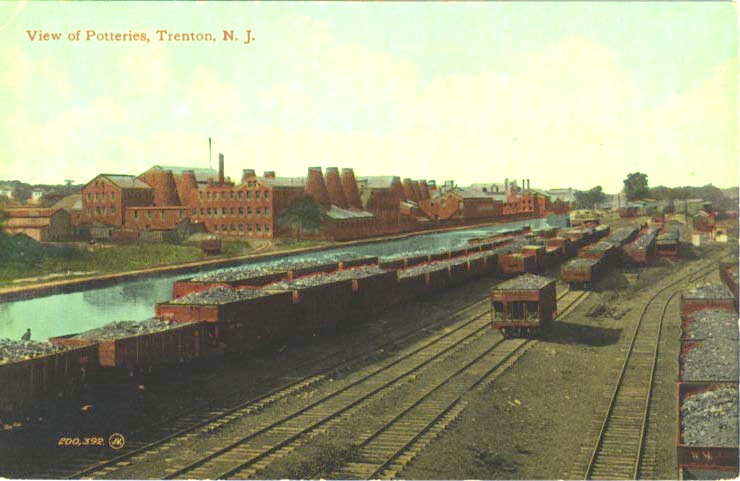
Easy access to transportation was so important to the industry that the majority of potteries were located along the canal and/or the railroads. By the 1860s and 1870s, close to a dozen industrial potteries, including the City Pottery, the Etruria Pottery and the Excelsior Pottery, were ranged along the Delaware and Raritan Canal. Just north of the city was a section known as Coalport, which emerged around a group of railroad sidings where shipments of coal were unloaded for industrial use. Some of Trenton’s largest potteries were based there, including the Etruria Pottery Works, Coxon & Company’s Pottery, John Maddock & Sons Coalport Works, and the Mercer Pottery. By the late 1870s, the pottery industry had also expanded southeast of the city along the canal and railroad into the neighboring community of Lamberton, with the dominant pottery in this area eventually being the Maddock Pottery Company’s Lamberton Works (later the Scammell China Company).
Sanitary Pottery

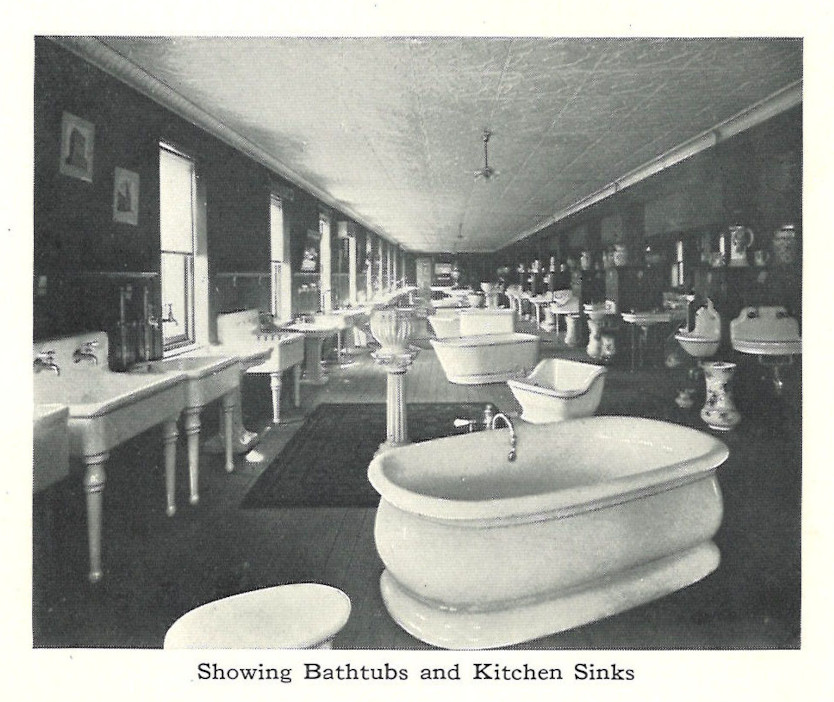
Sanitary pottery, also known as sanitary ware or sanitary porcelain, was an important ceramic product manufactured in Trenton. As indoor plumbing became widespread in the 1870s, the need for toilets, sinks and bathtubs grew. Since Trenton was already home to a thriving industrial pottery business it was a logical place in which to manufacture sanitary pottery. This was not lost upon Thomas Maddock, an English immigrant and pottery entrepreneur. He moved to Trenton from New York in 1873 to become part owner of the Carroll Street Pottery and began experimenting in the manufacture of sanitary pottery. Maddock was instrumental in developing the toilet flushing mechanism and had a number of patents for improvements to water closet design. Within a few years, the Carroll Street Pottery had switched to making predominantly sanitary wares.
The Enterprise Pottery

“The business of the Enterprise Pottery, on New York Avenue, was established in 1880. Earthenware closets, druggists’ vitrified ware, plumbers’ earthenware, stationary wash-stand basins, decorated toilet ware, and other earthenware in general are manufactured, a specialty being made of sanitary goods, and shipped principally to New York and Philadelphia. The manufacturing capacity of this establishment is one hundred and twenty-five thousand dollars annually, and fifty hands are employed.”
— Woodward, E.M. and J.F. Hageman. 1883. History of Burlington and Mercer Counties. Everts and Peck, Philadelphia, Pennsylvania.

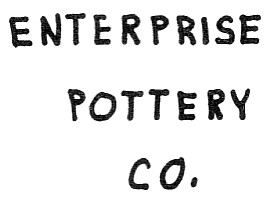
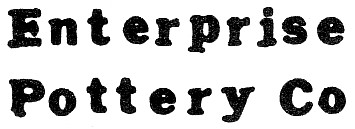

The Enterprise Pottery was the first factory in Trenton purpose-built for the mass production of sanitary wares. The origins of the pottery lie in the formation in 1873 of the Enterprise Land Company which purchased 228 acres along the canal in north Trenton for subdivision and development. Sometime between 1866 and 1873 a canal basin was built near the site of the present Enterprise Pottery building, and the Phillips Firebrick Works was subsequently established. Firebricks, essential building blocks for kilns and fireplaces, were made on the site until about 1880; the works produced 350,000 bricks in its final year in business (at which time it was known as the Trenton Fire Brick Company).
The Enterprise Pottery Company was founded around 1880 through the creation of a partnership by Charles H. Skirm, Richard Brian, William H. Umpleby and George Knowles. Skirm was a member of a prominent Trenton family and was involved in numerous business and real estate ventures in the city, many of them centering on the pottery industry. In addition to being President of the Enterprise Pottery Company, he served as Trenton postmaster (1872-1876), Mercer County sheriff (1879-1882), and President of the Trenton Water Association (1894-1900). Brian was born in Longton, Staffordshire, trained as an apprentice potter in England, and moved to the United States in 1870, where he found employment in Trenton’s pottery industry. Umpleby, like Thomas Maddock, experimented in the design of water closets and might have been responsible for the design of the sanitary ware produced by the Enterprise Pottery. In the 1880s he filed for and received three patents for water closet design.
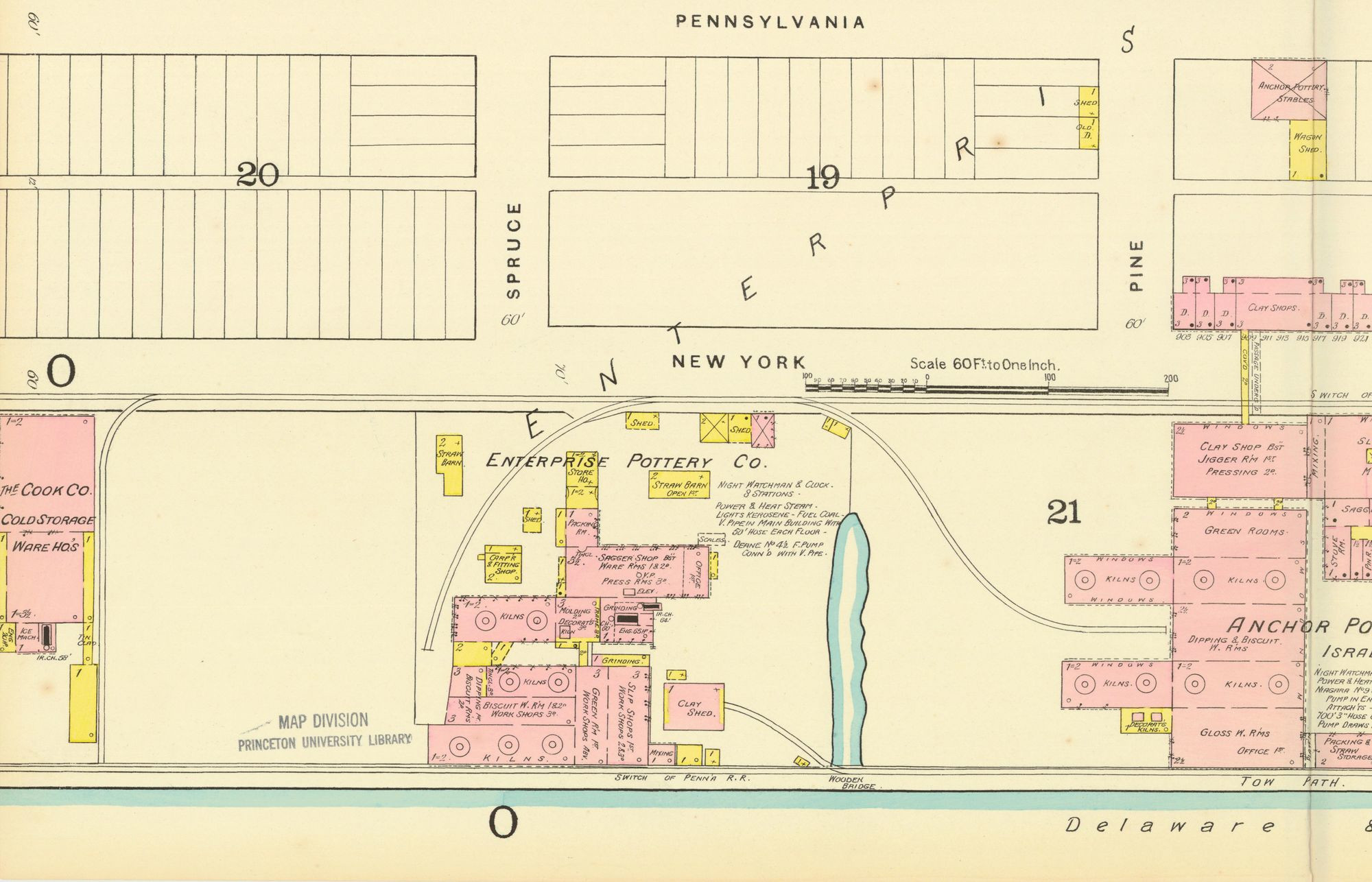
The Enterprise Pottery was built on a tract of land comprising the lot formerly occupied by the Phillips Firebrick Works and an additional 100 by 300-foot lot. The pottery had a 350-foot frontage on the Delaware and Raritan Canal and a 300-foot frontage on the railroad. By 1887 it employed 120 workers, had five kilns and produced $200,000 in goods annually. It manufactured a wide range of items, such as earthenware closets, druggists’ vitrified ware, plumbers’ earthenware, sanitary washstand basins and decorated toilet ware.
“… the main building has a frontage along the canal of 350 feet, and along the railroad of 300 feet. There are several buildings on the premises, in all covering about five acres, and making one of the most extensive, if not the largest in its special line in the country. The output of the Enterprise Pottery consists of sanitary earthenware exclusively … The plant consists of seven 16 feet 6 inches kilns, which since their erection have been running to their full capacity; a seventy-five-horse power engine furnishes the motive power, and to its aid is called the services of one hundred and fifty skilled operatives. They have a decorating establishment, where customers can always find a full line of decorated washouts, basins, etc., equal to any produced in the country. ”
— J.M. Elstner & Co. 1889. New Jersey's Leading Cities Illustrated: Historical, Biographical, Commercial Review of the Progress in Commerce, The Professions and in Social, Municipal Life. J.M. Elstner & Co., New York, New York, page 90.

Comparison of historic maps indicates the site underwent a major reconstruction in the 1880s, after which the property included a three-story building (with elevator) housing a sagger shop in the basement, a first-floor office, ware rooms on the first and second floors and press rooms on the third floor. To this were attached a three-story molding and decorating building, a one-story engine house and grinding room, three-story structures containing slip shops, workshops, a green room, and dipping and biscuit rooms. Seven bottle kilns rose up from within three two-story wings. Two detached buildings held straw for packaging, and a one-story clay shed was served by a railroad siding. The siding crossed the mouth of the old canal basin on a wooden bridge. In the first quarter of the 20th century the complex expanded again. By 1927 another kiln had been added, new concrete clay bins were built over the filled-in basin, and another story had been added to the principal workshop building.
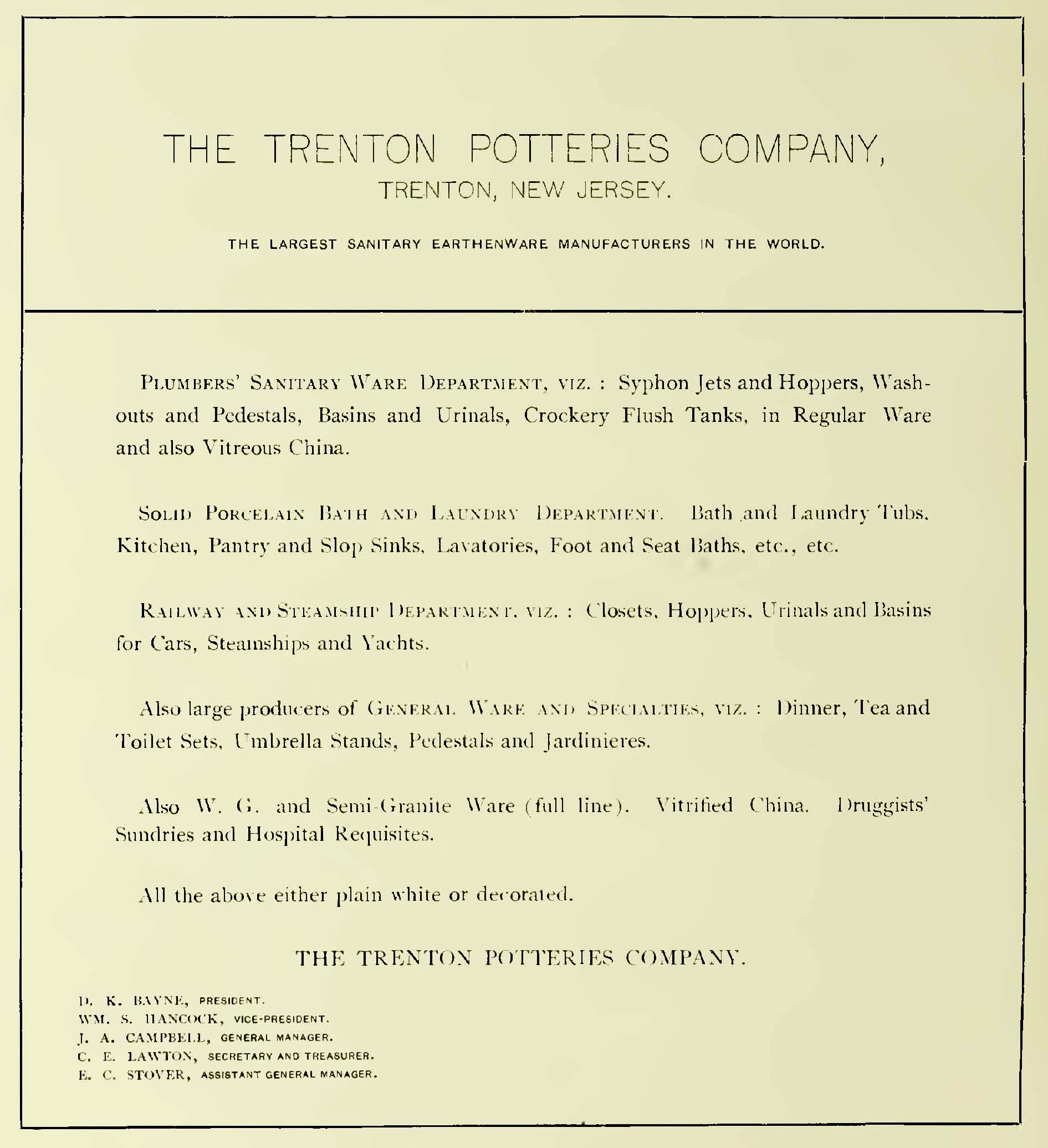
The Enterprise Pottery enjoyed a long and distinguished career as one of Trenton’s foremost industrial concerns. In 1892 it joined with four other sanitary ware potteries in Trenton (Crescent, Delaware, Empire and Equitable) to form the Trenton Potteries Company. The Enterprise Pottery was known as Plant No. 4, but continued to be listed in city directories under the name “Enterprise” until 1916. Although acting as one in terms of marketing and distribution of finished wares, each pottery continued to operate separately, managed by whomever owned the company before the merger.
Like most of Trenton’s potteries, the Enterprise Pottery was ultimately a casualty of the Depression and the decline in the use of ceramic materials that accompanied the rise of plastics. The number of potteries in Trenton dwindled to around 30 in the early 1930s and by the end of World War II only 18 were listed as being in operation. In 1941 the Enterprise Pottery was sold to a wholesale supply company and in 1971 to a moving and storage company. The buildings were demolished in 2022.
Enterprise Pottery Flythrough
Created By: Colliers Engineering and Design, Mount Arlington, NJ; 2022
References
Goldberg, David J, Preliminary Notes on the Pioneer Potters and Potteries of Trenton, N.J.: The First Thirty Years - 1852 - 1882 (And Beyond), Privately published, Trenton, New Jersey. 1998.
Naar, Day & Naar, A Review of the
Harney, W.J. Trenton's First Potteries. Sunday Times Advertiser, July 7, 14, 21 and 28, 1929.
Hunter Research, Inc., Teacups to Toilets: A Century of Industrial Pottery in Trenton, Circa 1950-1940, 1998.
J.M. Elstner & Co., New Jersey's Leading Cities Illustrated: Historical, Biographical, Commercial Review of the Progress in Commerce, The Professions and in Social, Municipal Life, 1889.
John Milner & Associates, Inc., Historic American Engineering Record Documentation of the Enterprise Pottery, Route 1SB Over New York Avenue, City of Trenton, Mercer County, New Jersey. Library of Congress. 1995
Lee, Francis Bazley, Genealogical and Personal Memoir of Mercer County, New Jersey, Lewis Publishing Co., New York. 1907.
Lehner, Lois, Lehner's Encyclopedia of U.S. Marks on Pottery, Porcelain & Clay. Collector Books, Paducah, Kentucky. 1988.
Naar, Day & Naar, A Review of the Department of Police, Trenton, New Jersey, with Copious Illustrations and Sketches Descriptive of its Economy, 1899.
Naar, Day & Naar, A Review of the Quarter-Century's Progress of New Jersey's Leading Manufacturing Centres, Dover International Publishing Company, New York. 1887.
Trenton State Gazette, "New Pottery on the Co-operative Plan," Saturday, February 21, 1880.
Trenton State Gazette, "City and County" Tuesday, July 27, 1880.
Van Hoesen, Walter Hamilton, Crafts and Craftsmen of New Jersey, Associated University Presses, Inc., Cranbury, New Jersey. 1973.
Woodward, E.M. and J.F. Hageman, History of Burlington and Mercer Counties. Everts and Peck, Philadelphia, Pennsylvania. 1883.

